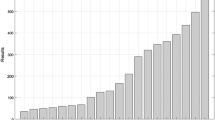Abstract
In the last years, there has been a growing interest in composite indices, whether they be social, socio-economic or environmental indices. In this paper, we propose a new approach to the composite indices construction which consists in computing an interval of possible values, for each statistical unit, rather than a single value. The interval is called ‘performance interval’ and it is constructed depending on the level of compensability of individual indicators. As an example of application, we considered a set of indicators of well-being in Italy and we constructed the performance intervals for the Italian Regions. Finally, we compared the midpoint of the performance intervals with the geometric mean, a classic partially compensatory aggregation function.


Similar content being viewed by others
Notes
Normalization step aims to make the indicators comparable, because they often have different measurement units and ranges (Mazziotta and Pareto 2017).
Note that compensability/non-compensability does not imply dependence/independence and vice versa. For example, “Hospital beds (per 1000 people)” and “Hospital doctors (per 1000 people)” are two dependent (positively correlated) indicators but they are non-substitutable, because a deficit in beds cannot be offset by a surplus in doctors and vice versa (Mazziotta and Pareto 2016).
Note that a simple non-compensatory approach uses the minimum (maximum) value of the normalized indicators so that the other values cannot increase (decrease) the value of the index. This function realizes the maximum penalization for unbalanced values of the indicators (Casadio Tarabusi and Guarini 2013).
A composite index can summarize values of different type (e.g., sample estimates, model-based estimates and census estimates).
The polarity of an individual indicator is the sign of the relation between the indicator and the phenomenon to be measured. When a composite index must be constructed, all the individual indicators must have positive polarity, so it is necessary to ‘invert’ the sign of the indicators with negative polarity (Mazziotta and Pareto 2017).
Often the minimum and maximum are outliers that can heavily affect the mean value.
References
Alaimo, L. S., & Maggino, F. (2020). Sustainable development goals indicators at territorial level: Conceptual and methodological issues—The Italian perspective. Social Indicators Research, 147, 383–419.
Bandura, R. (2011). Composite indicators and rankings: Inventory 2011. Technical report, Office of Development Studies, United Nations Development Programme (UNDP), New York.
Casadio Tarabusi, E., & Guarini, G. (2013). An Unbalance Adjustment Method for Development Indicators. Social Indicators Research, 112, 19–45.
Chiappero-Martinetti, E., & von Jacobi, N. (2012). Light and shade of multidimensional indexes. How Methodological Choices Impact on Empirical Results. In: F. Maggino, G. Nuvolati (eds), Quality of life in Italy, Research and Reflections (pp. 69–103). Social Indicators Research Series, 48. Springer, Cham.
Greco, S., Ishizaka, A., Tasiou, M., & Torrisi, G. (2019). On the methodological framework of composite indices: A review of the issues of weighting, aggregation, and robustness. Social Indicators Research, 141, 61–94.
Istat. (2018). BES 2018. Il benessere equo e sostenibile in Italia. Roma: Istituto Nazionale di Statistica.
Mazziotta, M., & Pareto, A. (2016). On a generalized non-compensatory composite index for measuring socio-economic phenomena. Social Indicators Research, 127, 983–1003.
Mazziotta, M., & Pareto, A. (2017). Synthesis of indicators: The composite indicators approach. In: F. Maggino (Ed.), Complexity in society: From indicators construction to their synthesis (pp. 159–191). Social Indicators Research Series, 70. Springer, Cham.
Mazziotta, M., & Pareto, A. (2019). Use and Misuse of PCA for Measuring Well-Being. Social Indicators Research, 142, 451–476.
OECD. (2008). Handbook on constructing composite indicators. Methodology and user guide. Paris: OECD Publications.
Saisana, M., Saltelli, A., & Tarantola, S. (2005). Uncertainty and sensitivity analysis techniques as tools for the quality assessment of composite indicators. Journal of the Royal Statistical Society. Series A: Statistics in Society, 168(2), 307–323.
Saisana, M., & Tarantola, S. (2002). State-of-the-art report on current methodologies and practices for composite indicator development. European Commission-JRC, EUR 20408 EN, Ispra.
UNDP. (2010). Human Development Report 2010. New York: Palgrave Macmillan.
UNDP. (2018). Human Development Indices and Indicators. 2018 Statistical Update. New York: United Nations Development Programme.
Zhou, P., Ang, B. W., & Zhou, D. Q. (2010). Weighting and aggregation in composite indicator construction: A multiplicative optimization approach. Social Indicators Research, 96, 169–181.
Acknowledgements
The paper is the result of the common work of the authors: in particular M. Mazziotta has written Sects. 2, 3, 6, and A. Pareto has written Sects. 1, 4, 5.
Author information
Authors and Affiliations
Corresponding author
Additional information
Publisher's Note
Springer Nature remains neutral with regard to jurisdictional claims in published maps and institutional affiliations.
Rights and permissions
About this article
Cite this article
Mazziotta, M., Pareto, A. Composite Indices Construction: The Performance Interval Approach. Soc Indic Res 161, 541–551 (2022). https://doi.org/10.1007/s11205-020-02336-5
Accepted:
Published:
Issue Date:
DOI: https://doi.org/10.1007/s11205-020-02336-5




